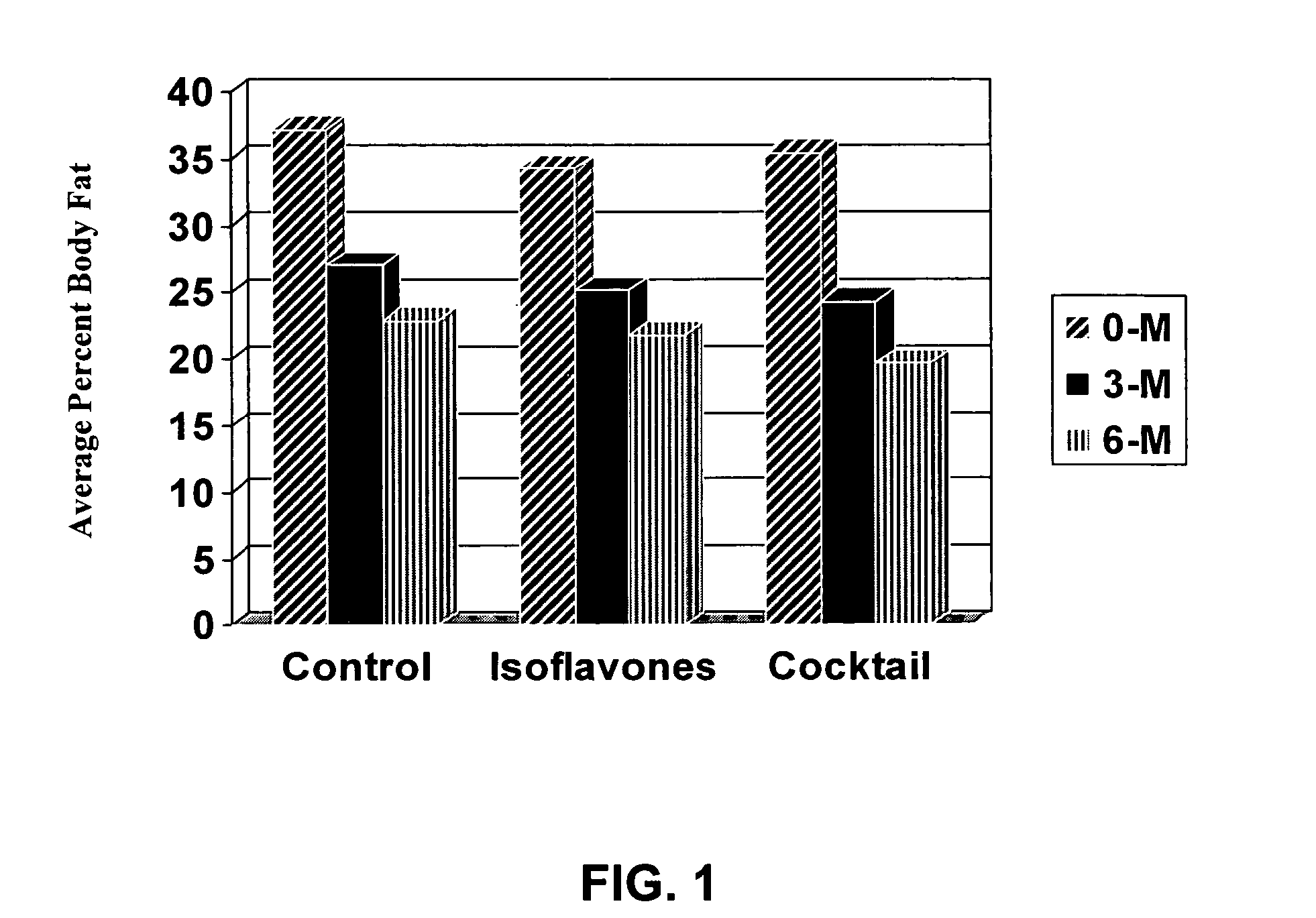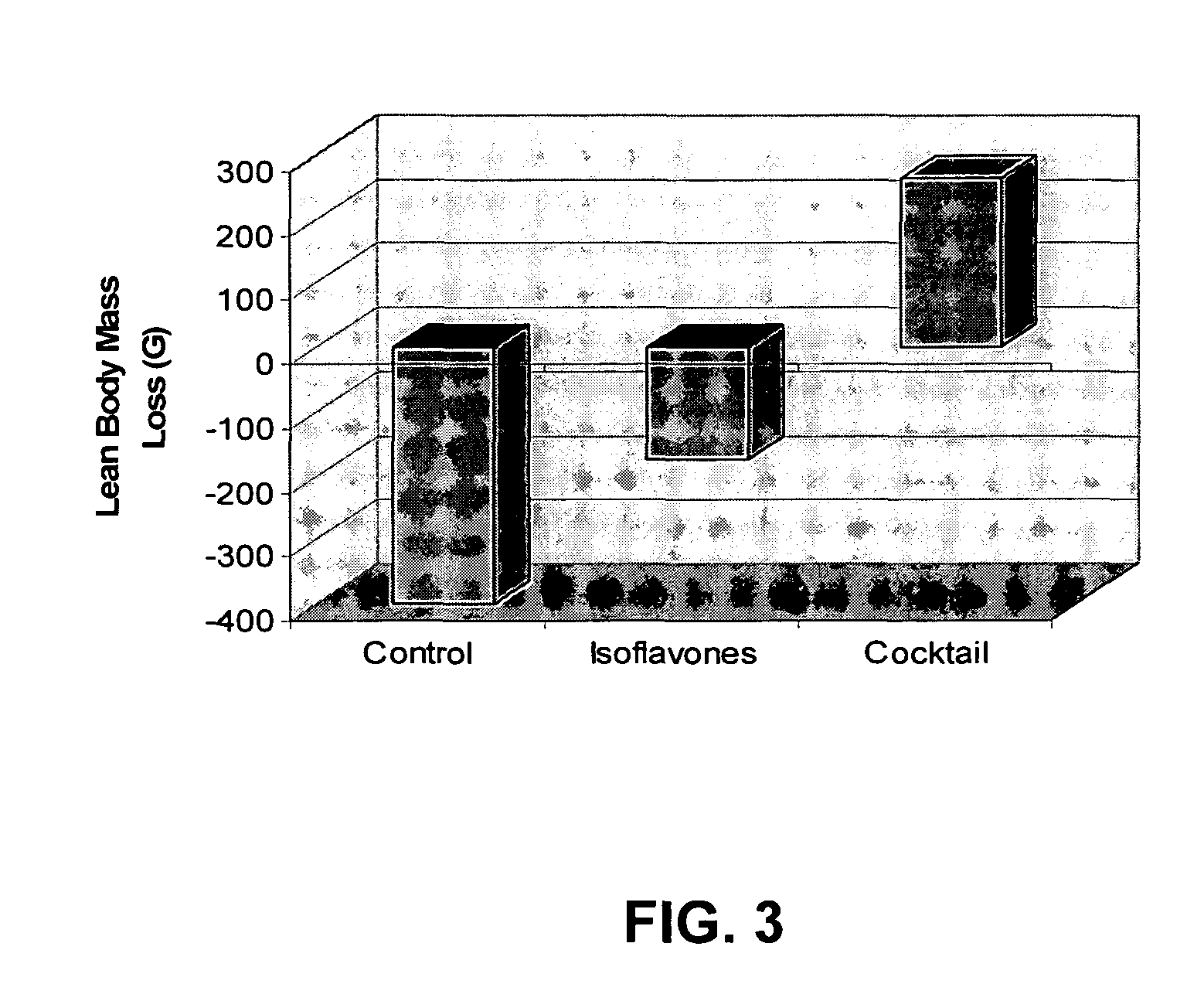Compositions and methods for reducing or preventing obesity
a technology of compositions and methods, applied in the field of companion and other domestic animals' nutrition, can solve the problems of increasing the risk of the development of a number of chronic diseases, animals being overweight or obese, and dogs that are overweight or obese, so as to minimize the loss of lean body mass, promote fat breakdown, and maximize body fat loss
- Summary
- Abstract
- Description
- Claims
- Application Information
AI Technical Summary
Benefits of technology
Problems solved by technology
Method used
Image
Examples
example 1
Weight Loss
[0091]Overweight dogs (Male: >22% Body Fat; Female >26% Body Fat) were used. Group 1 (Control diet) consisted of 9 Labrador Retrievers (LRs) and 6 Siberian Huskies (SHs). Group 2 (Isoflavone diet) consisted of 8 LRs and 6 SHs. Group 3 (Cocktail diet) consisted of 7 LRs and 8 SHs.
[0092]Animals fed the Control diet (Group 1) received a traditional low caloric diet: 1400 Kcal / lb, 25% protein, 6% fat, 7% crude fiber. Animals fed the Isoflavone diet (Group 2) were fed the control diet containing 10% Soy Germ Meal (SGM). Animals fed the Cocktail diet (Group 3) were fed the control diet containing 10% SGM, 1.5% conjugated linoleic acid (CLA), and 100 parts per million (ppm) 1-carnitine.
[0093]All dogs were given a pre-study MER determination. All dogs were fed 70% of their maintenance energy requirement (MER) during the first 3 months of weight loss. At 3 months, animals were assayed by Dual Energy X-ray Absorptiometry (DEXA). Dogs that failed to reach the ideal body fat level (m...
example 2
Weight Management
[0107]Non-obese dogs that were spayed or neutered (Male: <17.5% Body Fat; Female <20% Body Fat, referred to as “normal” dogs) were used in the study. Group 1 (Control diet) consisted of 13 Labrador Retrievers (LRs). Group 2 (Isoflavone diet) consisted of 14 LRs. Group 3 (Cocktail diet) consisted of 15 LRs.
[0108]Animals fed the Control diet (Group 1) received a standard superpremium diet: 1900 Kcal / lb, 30% protein, 17% fat. Animals fed the Isoflavone diet (Group 2) were fed the control diet containing 10% Soy Germ Meal (SGM). Animals fed the Cocktail diet (Group 3) were fed the control diet containing 10% SGM, 1.5% conjugated linoleic acid (CLA), and 100 parts per million (ppm) 1-carnitine.
[0109]The maintenance energy requirement (MER) of all dogs was determined prior to the feeding study. All dogs were fed 125% of their MER during the 12 months of feeding study.
[0110]The following measurements were made for each animal:[0111]Body weight, body condition score, DEXA.[...
PUM
| Property | Measurement | Unit |
|---|---|---|
| mass | aaaaa | aaaaa |
| digestibility | aaaaa | aaaaa |
| lean body mass | aaaaa | aaaaa |
Abstract
Description
Claims
Application Information
 Login to View More
Login to View More - R&D
- Intellectual Property
- Life Sciences
- Materials
- Tech Scout
- Unparalleled Data Quality
- Higher Quality Content
- 60% Fewer Hallucinations
Browse by: Latest US Patents, China's latest patents, Technical Efficacy Thesaurus, Application Domain, Technology Topic, Popular Technical Reports.
© 2025 PatSnap. All rights reserved.Legal|Privacy policy|Modern Slavery Act Transparency Statement|Sitemap|About US| Contact US: help@patsnap.com



